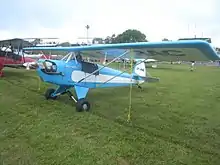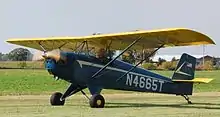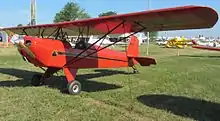Ace Baby Ace
The Ace Baby Ace was the world's first aircraft to be marketed as a homebuilt aircraft when its plans were offered for sale in 1929. Plans are still available and Baby Aces are still being built today. Orland Corben designed a series of aircraft for the Ace Aircraft Manufacturing Company, the Baby Ace, Junior Ace, and Super Ace. Corben's name was associated with the aircraft, and it is commonly known as the Corben Baby Ace.[2]
| Ace Baby Ace | |
|---|---|
 | |
| Role | Sports aircraft |
| National origin | USA |
| Manufacturer | Acro Sport |
| Designer | Orland Corben |
| Number built | 453 (2011)[1] |




Design
It is a single-seat parasol wing monoplane of conventional taildragger configuration. Individual examples have been configured with tricycle landing gear.[3] The fuselage is of fabric-covered tubular construction and the wings are wood. The first example flew with a Heath-Henderson B-4 modified motorcycle engine.[4] A variety of aircraft powerplants may be used, typically in the 65-100 hp (50-75 kW) range. Examples have been built using 70 hp Corvair engines.[5]
Operational history
The Baby Ace kits and production models were constructed in Madison, Wisconsin. In America, state and federal laws banned homebuilding and flight in the uncertified designs by 1938. In 1948, Experimental aircraft were allowed to be built again in America. In 1952 Paul Poberezny, founder of the Experimental Aircraft Association bought the rights to the Ace aircraft for $200, and produced a sub-$800 Baby Ace that was featured in Mechanix Illustrated. The series of articles were in conjunction with a CAA effort to revitalize American aviation by promoting amateur built aircraft.[2] A 1958 Baby Ace is currently the oldest Canadian homebuilt aircraft flying.[6]
Variants
- Baby Ace
- Single-seat
- Super Ace
- Single-seat powered by a Ford Model A Automovie engine. Plans updated by EAA founder Paul Poberezny.
- Jr. Ace
- Two-seat tandem variant.
- Pober Jr Ace
- Updated plans of the Jr. Ace model
Specifications (Baby Ace D)
Data from [7]
General characteristics
- Crew: 1
- Length: 17 ft 8.75 in (5.4039 m)
- Wingspan: 26 ft 5 in (8.05 m)
- Height: 6 ft 7.75 in (2.0257 m)
- Wing area: 112.3 sq ft (10.43 m2)
- Aspect ratio: 6.21
- Airfoil: Clark Y (modified)
- Empty weight: 575 lb (261 kg)
- Max takeoff weight: 950 lb (431 kg)
- Fuel capacity: 36.4 l (9.6 US gal; 8.0 imp gal)
- Powerplant: 1 × Continental A65 / Continental A80 / Continental C65 / Continental C85 / (Salmson, Szekely, or Anzani equivalents) 4-cylinder air-cooled horizontally-opposed piston engines 65–85 hp (48–63 kW)
- Propellers: 2-bladed fixed-pitch propeller
Performance
- Maximum speed: 110 mph (180 km/h, 96 kn) at sea level (65 hp (48 kW) engine at max. T-O weight
- Cruise speed: 100 mph (160 km/h, 87 kn) to 105 mph (91 kn; 169 km/h) max.
- Stall speed: 34 mph (55 km/h, 30 kn)
- Range: 350 mi (560 km, 300 nmi) with max fuel
- Service ceiling: 16,000 ft (4,900 m)
- Rate of climb: 1,200 ft/min (6.1 m/s)
- Take-off run: 200 ft (61 m)
- Landing run: 250 ft (76 m)
See also
Aircraft of comparable role, configuration, and era
References
- Vandermeullen, Richard: 2012 Kit Aircraft Buyer's Guide, Kitplanes, Volume 28, Number 12, December 2011, page 37. Belvoir Publications. ISSN 0891-1851
- "The Baby Ace". Experimenter. February 1955.
- "EAA Fly-In". Flying Magazine: 37. November 1960.
- David A Gustafson (October 1991). "Baby Ace". Air Progress.
- "none". Air Trails: 14. Winter 1971.
- "Tiger Boy's Airplane Works". Retrieved 6 May 2011.
- Taylor, John W.R.; Munson, Kenneth, eds. (1977). Jane's all the World's Aircraft 1977–78 (68th ed.). London: Jane's Yearbooks. pp. 516–517. ISBN 9780531032787.
- Our Wisconsin magazine ("Ace High" C Boelk) June/July 2015
External links
| Wikimedia Commons has media related to Ace Baby Ace. |
- Web site of Ace Aircraft provides info on the kit for building the Corben Baby Ace Model D.
- The History of Ace Aircraft